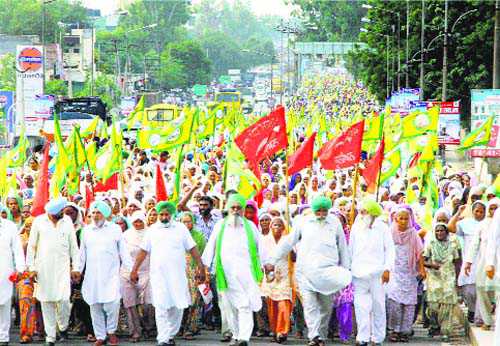
The farmer is a link in the food-security chain. Farmers protest in Bathinda. PTI
Satish Verma
Punjab and Haryana are the two states in northern India where agriculture is in deep crisis and the farmers are reeling under debt; which is one of the several contributory factors causing them to commit suicides. The crisis is more grave in Punjab, where the spate of farmers’ suicides is much more alarming. Farmers’ distress is surfacing in the widespread agitations, protest rallies and blockade of rail traffic. These developments have caused economic, political and social tensions and also weakened the economy of the state.
The magnitude of indebtedness in Punjab is more than in Haryana. In 2002, according to the NSSO, (2003), the incidence of indebtedness of cultivator households in Punjab was less (28.5 per cent), while it was higher in Haryana (31.7 per cent). The cultivator household is one operating at least 0.002 hectares of land during the preceding 365 days. The NSSO, in 2013, estimated it for the year 2012 at 40.19 per cent in Punjab and 32.92 per cent in Haryana. While the proportion of indebted cultivator households remained almost the same in Haryana, it rose sharply (by over 40 per cent) in Punjab during the last decade. In Punjab, the incidence of indebtedness amongst cultivator households with outstanding loans too rose sharply. The state registered a higher increase in the average amount of debt outstanding per such household. Against the average amount of cash loan per cultivator household in 2002, the average amount of debt in 2012 was 8.56 times (21 times if we take the average amount of debt per cultivator household with outstanding loans).
The corresponding figures for Haryana were 5.72 times (17 times). A much higher increase, both in the incidence as well as in the average amount of outstanding debt per cultivator household, resulted into a much larger increase in outstanding debt against these households in Punjab. Loans from non-institutional sources contribute to the debt burden. Their share, according to NSSO, in outstanding debt in rural areas in Punjab was 43.6 per cent in 2002. In a study, “Rural credit and financial penetration in Punjab”, estimated it at 40.22 per cent in December, 2013. These sources charged an exorbitant 18 to 36 per cent rate of interest on two-third of their loans in rural areas, while institutional sources charged a maximum of 12.5 per cent rate of interest on 97 per cent of their loans to these households. The high rate of interest on a significant component (40 per cent) of outstanding debt by non-institutional sources has further compounded their problems. According to the factual data, collected quarterly by the State-Level Bankers Committee (SLBC), the amount of KCC loans outstanding, which are crop loans, as on ending March 2015, was Rs 52,225.57 crore in Punjab and Rs 30,363.99 crore in Haryana.
This amount represents only the short-term loans and excludes long-term or the investment part of outstanding institutional loans. By adding the 40 per cent non-institutional component, the total indebtedness of these households on account of crop loans alone, worked out to Rs 73,115.80 crore in Punjab as on ending March 31, 2015. The corresponding figure in the case of Haryana worked out to Rs 42,509.59 crore, yielding 72 per cent higher indebtedness in Punjab than in Haryana. This amount of indebtedness is to the exclusion of the investment loans outstanding against these households.
Undoubtedly, outstanding loans will have to be repaid. This necessitates an increase in incomes. The farmer is an important link in the food security chain. He alone faces the vagaries of monsoon, devastating pest attacks, floods, delayed payments, and sometimes even has to sell his produce at less than the Minimum Support Price.
The writer is RBI Chair Professor, Centre for Research in Rural and Industrial Development, Chandigarh.



























